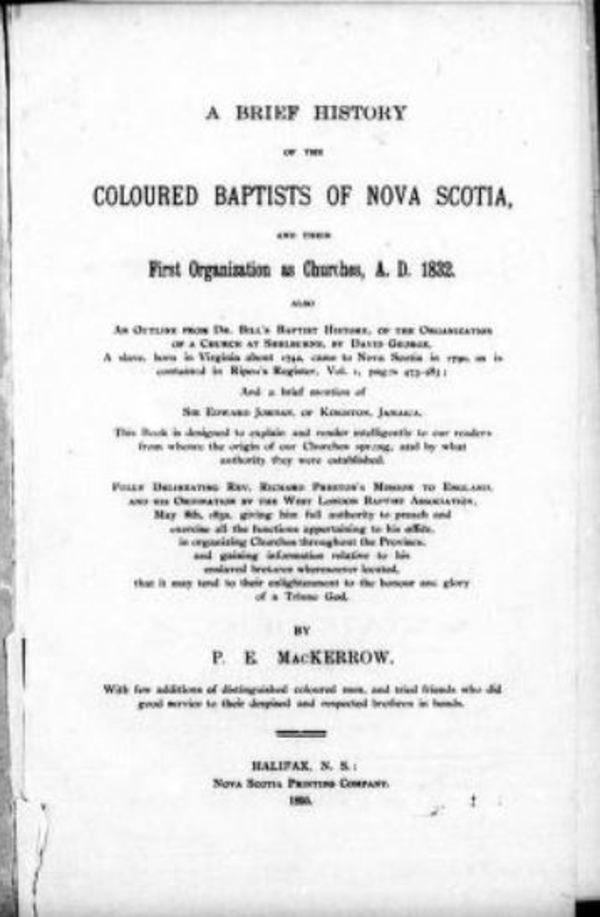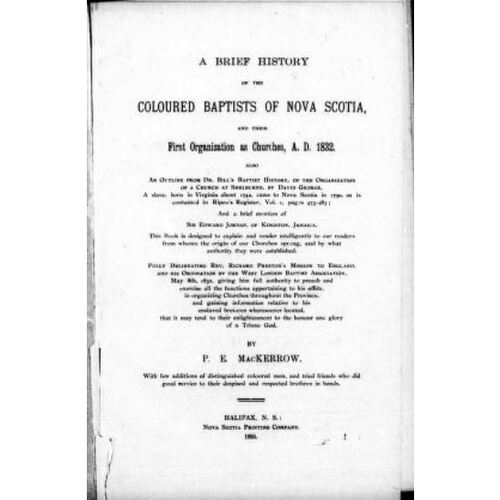
Source: Link
McKERROW (MacKerrow), PETER EVANDER, historian and community leader; baptized 19 Feb. 1841 in Antigua (Antigua Barbuda), son of Peter McKerrow, a shoemaker, and Susannah Evanson; m. 10 Feb. 1863 Mary Elizabeth Thomas (d. 1897) in Halifax; d. there 22 Dec. 1906 of tuberculosis.
Very little is known about Peter Evander McKerrow’s family background except that he claimed Scottish descent through his father. Like most young West Indians who emigrated to Nova Scotia in the 19th century, McKerrow arrived in Halifax as a sailor, apparently possessed of a good common-school education. The critical feature of his early years in Nova Scotia was his absorption into the Thomas family, headed by Welsh-born James Thomas and his African-Nova Scotian wife, Hannah Saunders. McKerrow not only married the eldest daughter of the Thomases, but also established a hat, cap, and fur business, Thomas and Company, with his father-in-law and family, which lasted in its Barrington Street location until 1894. The other major Thomas influence in his life was religion. In 1874 McKerrow joined the African Baptist church, in which the white James Thomas was a leading preacher from 1857 until his death in 1879.
McKerrow emerged as the most articulate and one of the most active and respected Black secular leaders of the last quarter of the 19th century in Halifax. He achieved this status through devotion to his work and family, service to his church, executive positions in Black branches of international white, secular organizations, and participation during the 1870s in the first Black rights movement.
McKerrow’s family-centred occupation gave him the wherewithal to educate the daughter and four sons who survived childhood. The three eldest boys followed him into the bookkeeping end of the fur business, while the youngest studied medicine in Montreal before emigrating to Massachusetts. After the dissolution of the Thomas firm, McKerrow worked with his eldest son, James Thomas, who established a fur business on Granville Street. On James’s emigration to central Canada about 1900, the senior McKerrow either retired or followed the example of his brother-in-law William B. Thomas by becoming a wage-earner in a fur business run by whites.
In his church McKerrow’s activities were those of a dedicated layman. Unlike his father-in-law and two of his brothers-in-law, he did not serve as an ordained or licensed preacher. He did, however, act as secretary of the African Baptist Association of Nova Scotia for 30 consecutive years from 1875, a position which permitted him to deliver an annual message to the members, and he was a trustee and deacon of Cornwallis Street Church in Halifax as well as long-time superintendent of its Sunday school. In 1895 he published A brief history of the coloured Baptists of Nova Scotia and their first organization as churches, A.D. 1832 . . . (Halifax), which gave him the distinction of being the first Black historian of the province. By showing the diverse origins of the church under influences from Africa, Britain, the United States, and the West Indies, the work helped to confirm the multi-ethnic character of local Black cultural institutions.
In both religious and secular organizations, McKerrow preferred racial integration to separate or parallel structures, at least at the policy-making level. To this end he tried unsuccessfully to promote the integration of the African Baptist Association and the Maritime Baptist convention. He also valued his role as a representative of Black fraternal lodges in the racially integrated grand councils of the region. These activities focused on Union Lodge No.18 of the freemasons, which he joined in 1866 and chronicled in a brief pamphlet in 1906, and on Morning Glory Lodge of the Independent Order of Good Templars, a temperance organization. In both these Black lodges McKerrow held all the major executive positions at one time or another, and he joined the successful campaign to keep the American colour-line out of their provincial councils.
While McKerrow either endorsed or made the best of the “equal but separate” strategies of the lodges and the church, he drew the line at separation when it came to education, then considered the most important element for promoting the betterment of the “coloured” population of Nova Scotia. After a battle with the Halifax Board of School Commissioners in 1872 over the treatment of his eldest son, he contributed for the next two decades to the petitions, delegations, and public meetings in favour of equal educational opportunities for African-Nova Scotians in the public schools, arguing that as citizens who shared the same duties as whites, Blacks should also have the same rights [see Jane Bruce]. Both McKerrow’s pronouncements against the enforcement of segregated schooling in 1876 and his writings in general underscored a profound respect for old England, “that land whose laws have done so much for the African race,” ranging from emancipation of slaves to encouragement of Black involvement in associational life. By the end of the century McKerrow had decided that the American heritage of the Blacks also had its positive features, since the United States provided opportunities for education and employment which were not available in Nova Scotia. As he watched young, educated Blacks, including three of his sons, leave the province, he attributed the lack of opportunity for his people in economically ailing Nova Scotia to racial discrimination in the workplace, a far more intractable problem by the turn of the century than separate schooling or segregated societies.
A copy of Peter Evander McKerrow’s pamphlet A few scattering webs of memory in the semi-centennial history of Union Lodge, No.18, R.N.S., AF & AM ([Halifax, 1906]) is preserved among the masonic records at PANS, MG 20, 2130, no.34. A new edition of his church history, prepared by Frank Stanley Boyd Jr assisted by Mary I. Allen Boyd, was published in Halifax in 1976 as McKerrow: a brief history of the coloured Baptists of Nova Scotia, 1783–1895.
National Archives of Antigua Barbuda (St John’s, Antigua), Anglican church records, St Peter’s parish, reg. of marriages, 1835; Ecclesiastical Dist. of All Saints, reg. of baptisms, 1841. NA, RG 31, C1, 1871, 1881, 1891, Halifax (mfm. at PANS). PANS, MG 20, 2012, no.2; 2130, no.34; 2218; Places, Halifax, Board of School Commissioners, minutes, vols.4–9 (mfm.); Snow Funeral Home Ltd., burial reg., 1906 (mfm.); RG 14, ser.R, Halifax City, Lockman/Maynard Street; RG 32, 165, no.10. Acadian Recorder, 4 June 1879; 8 Dec. 1880; 22, 24 Dec. 1906. Daily Echo (Halifax), 27 Dec. 1906. Halifax Herald, 24 June 1892, 25 Dec. 1906. Maritime Baptist (Saint John, N.B.), 16 Jan. 1907. Morning Chronicle (Halifax), 27 July 1877, 26 Dec. 1906. Morning Herald (Halifax), 8 July 1880. African Baptist Assoc. of Nova Scotia, Minutes (Halifax), 1877–1907 (copies in the Atlantic Baptist Hist. Coll., Acadia Univ., Wolfville, N.S.). A. P. [Borden] Oliver, A brief history of the colored Baptists of Nova Scotia, 1782–1953 . . . ([Halifax, 1953]). Directory, Halifax, 1871/72–1906/7. Judith Fingard, “Race and respectability in Victorian Halifax,” Journal of Imperial and Commonwealth Hist. (London), 20 (1991–92): 169–95. R. W. Winks, The blacks in Canada: a history (Montreal, 1971).
Cite This Article
Judith Fingard, “McKERROW (MacKerrow), PETER EVANDER,” in Dictionary of Canadian Biography, vol. 13, University of Toronto/Université Laval, 2003–, accessed April 27, 2025, https://www.biographi.ca/en/bio/mckerrow_peter_evander_13E.html.
The citation above shows the format for footnotes and endnotes according to the Chicago manual of style (16th edition). Information to be used in other citation formats:
| Permalink: | https://www.biographi.ca/en/bio/mckerrow_peter_evander_13E.html |
| Author of Article: | Judith Fingard |
| Title of Article: | McKERROW (MacKerrow), PETER EVANDER |
| Publication Name: | Dictionary of Canadian Biography, vol. 13 |
| Publisher: | University of Toronto/Université Laval |
| Year of revision: | 1994 |
| Access Date: | April 27, 2025 |



